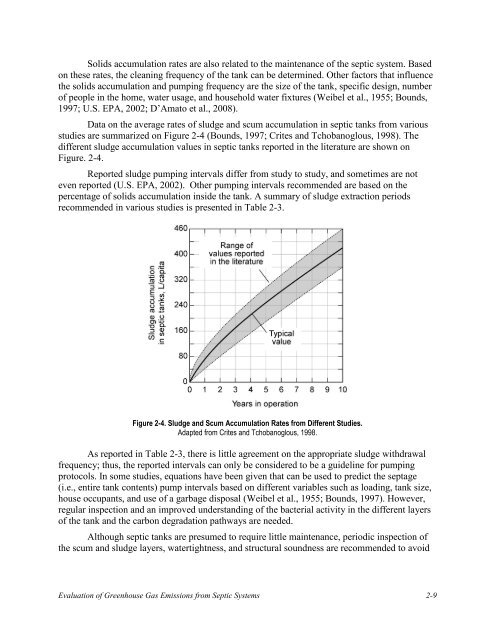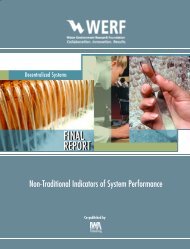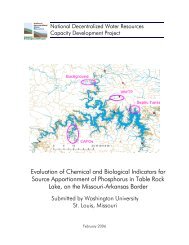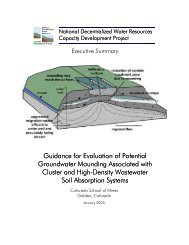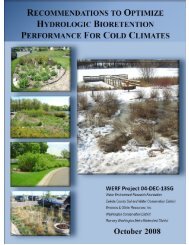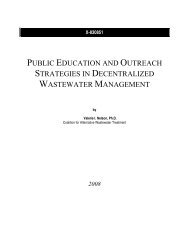Evaluation of Greenhouse Gas Emissions from Septic ... - Geoflow
Evaluation of Greenhouse Gas Emissions from Septic ... - Geoflow
Evaluation of Greenhouse Gas Emissions from Septic ... - Geoflow
You also want an ePaper? Increase the reach of your titles
YUMPU automatically turns print PDFs into web optimized ePapers that Google loves.
Solids accumulation rates are also related to the maintenance <strong>of</strong> the septic system. Basedon these rates, the cleaning frequency <strong>of</strong> the tank can be determined. Other factors that influencethe solids accumulation and pumping frequency are the size <strong>of</strong> the tank, specific design, number<strong>of</strong> people in the home, water usage, and household water fixtures (Weibel et al., 1955; Bounds,1997; U.S. EPA, 2002; D’Amato et al., 2008).Data on the average rates <strong>of</strong> sludge and scum accumulation in septic tanks <strong>from</strong> variousstudies are summarized on Figure 2-4 (Bounds, 1997; Crites and Tchobanoglous, 1998). Thedifferent sludge accumulation values in septic tanks reported in the literature are shown onFigure. 2-4.Reported sludge pumping intervals differ <strong>from</strong> study to study, and sometimes are noteven reported (U.S. EPA, 2002). Other pumping intervals recommended are based on thepercentage <strong>of</strong> solids accumulation inside the tank. A summary <strong>of</strong> sludge extraction periodsrecommended in various studies is presented in Table 2-3.Figure 2-4. Sludge and Scum Accumulation Rates <strong>from</strong> Different Studies.Adapted <strong>from</strong> Crites and Tchobanoglous, 1998.As reported in Table 2-3, there is little agreement on the appropriate sludge withdrawalfrequency; thus, the reported intervals can only be considered to be a guideline for pumpingprotocols. In some studies, equations have been given that can be used to predict the septage(i.e., entire tank contents) pump intervals based on different variables such as loading, tank size,house occupants, and use <strong>of</strong> a garbage disposal (Weibel et al., 1955; Bounds, 1997). However,regular inspection and an improved understanding <strong>of</strong> the bacterial activity in the different layers<strong>of</strong> the tank and the carbon degradation pathways are needed.Although septic tanks are presumed to require little maintenance, periodic inspection <strong>of</strong>the scum and sludge layers, watertightness, and structural soundness are recommended to avoid<strong>Evaluation</strong> <strong>of</strong> <strong>Greenhouse</strong> <strong>Gas</strong> <strong>Emissions</strong> <strong>from</strong> <strong>Septic</strong> Systems 2-9


